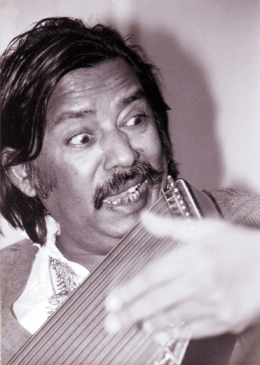The revolutionary duo
By Inayat Illahi Malik
Date:17-07-06
Source: Dawn
 THERE were two sides to Salamat Ali Khan’s personality. The artiste was proud, confident and defiant of redundant traditions; the man was modest, insecure, yet dignified. The music that he has left behind is a fascinating amalgam of the two it has dignity; it pulsates, defies the conformists and the orthodox, but it remains classical in the true sense of the term.
THERE were two sides to Salamat Ali Khan’s personality. The artiste was proud, confident and defiant of redundant traditions; the man was modest, insecure, yet dignified. The music that he has left behind is a fascinating amalgam of the two it has dignity; it pulsates, defies the conformists and the orthodox, but it remains classical in the true sense of the term.
Before independence, the Harvalbh Festival (of classical music) was the subcontinent’s most famous Sangeet Mela in which heavy-weights like Bhaskar Rao, Khan Sahib, Abdul Karim Khan, Abdul Waheed Khan, Fayaz Khan and Barre Ghulam Ali Khan used to participate. Pandit Omkar Nath Thankur used to encourage Salamat Ali, who was then hardly seven or eight, to sing; he would render the khyal while standing and in turn would receive a standing ovation.
[Photo: Amarjit Chandan, Southall London, 17 Nov. 1982]
In 1945, His Master`s Voice recording company bestowed a singular honour upon him by releasing his first gramophone record of Gujri Todi, Bhor bhai tori bat takat pia, which was originally composed and sung by Barre Ghulam Ali Khan. In 1967, when he came to know that I had a copy of the record he very graciously visited our house and brought his sons along who very much enjoyed the old, and the then young-master Salamat Ali`s singing at the age of seven.
He was the grandson of Mian Karim Bakhsh, one of the founders of the Sham Chaurasi Gharana. In one of the concerts in Jallandur, great maestro Bhaskar Rao paid a tribute as well as issued a warning to Mian Sahib while he was singing khyal bhairvin. Karim Bakhsh: Bhagwan kay liay (for God`s sake) stop your further pursuit of shudh swaras (purity of notes) or you will become a lunatic. It is said that some time after the warning Mian Sahib died while reciting bhairvin.
Salamat Ali Khan traced the ancestry of his gharana to legendry singers Chand Khan and Suraj Khan. Niaz Husain Shami, basically a Dhrupad singer, trained both the brothers Salmat Ali and Nazakat Ali in classical music in accordance with the traditions of the Sham Chaurasi Gharana. They used to sing jointly. In the early 1950s, Salamat Ali and his elder brother Nazakat Ali dominated the scene as the foremost singers of khyal, and were much sought after in the music concerts in Lahore, Multan, Rawalpindi and Karachi.
The fees then were not handsome. Radio and music concerts were the principal but tenuous source of income. It is indeed remarkable that in the formative years of Pakistan singers like Amanat Ali, Fateh Ali, Asad Ali Khan, Umeed Ali Khan, Chotay Ghulam Ali Khan, Mehdi Hassan, Surraya Multanikar, Iqbal Bano and other outstanding artistes like Sharif Khan, Ustad Nabi Bukhsh, Sadiq Ali Mando and Shaukat Husain, inspite of their insubstantial income, never let the audience have a feeling of dearth of top classical artistes and classical musicians in Pakistan.
This was the generation of singers who believed in Sudh (purest) Gaeky and strict adherence to grammar. They would not deviate from samagana, the method of singing vedic music or shastria sangeet. Salamat Ali, Nazakat Ali were revolutionary in the sense that they would not let the mere grammar curb their style. It was not that they were averse to a musical discipline; they reveled in it - but they insisted on certain artistic freedom to improvise or embellish in the sense that they did deviate from the style of the Khyal Gaekey in vogue to create an impact on the audience. And in this they always succeeded.
Unfortunately, the pair did not last very long and after some family feuds they had to part ways. However, they had left behind some of the sweetest memories of their beautiful recitals. A joint-recital by them was Rag Darbari in a live broadcast from Radio Pakistan, Lahore, in the 60s, which is still fresh in the memory of its listeners. Well-planned and of a solid structure, the singing showed profound knowledge of the architectonics of classical art. Starting with a slow Khayal Darbari, the artistes developed it in a gradual, tantalizing way, withholding any too precipitate revelation of the modal form. The music, despite its creative effusiveness, presented a living organic whole, governed as it was by a powerful and unerring sense of design.
The opening passage was almost always especially absorbing. Neatly moulded, and full of space and grace, they gave the impression of a general sense of fitness in the disposition of vocal effects. At the same time the singing showed a felicitous blend of classical abstractions and a genuine feeling for the lyrical and the picturesque.
Salamat Ali (the principal singer) rose to a high level of expressiveness. Always clear, flexible and chaste, his singing conveyed in a vivid manner the scope and character of his musical thought. The raga was brilliantly projected and there were many fascinating manifestations of its beauty and colour all along his singing career. To this was added a sense of emotional intensity, which made the singer`s utterance intimately communicative.